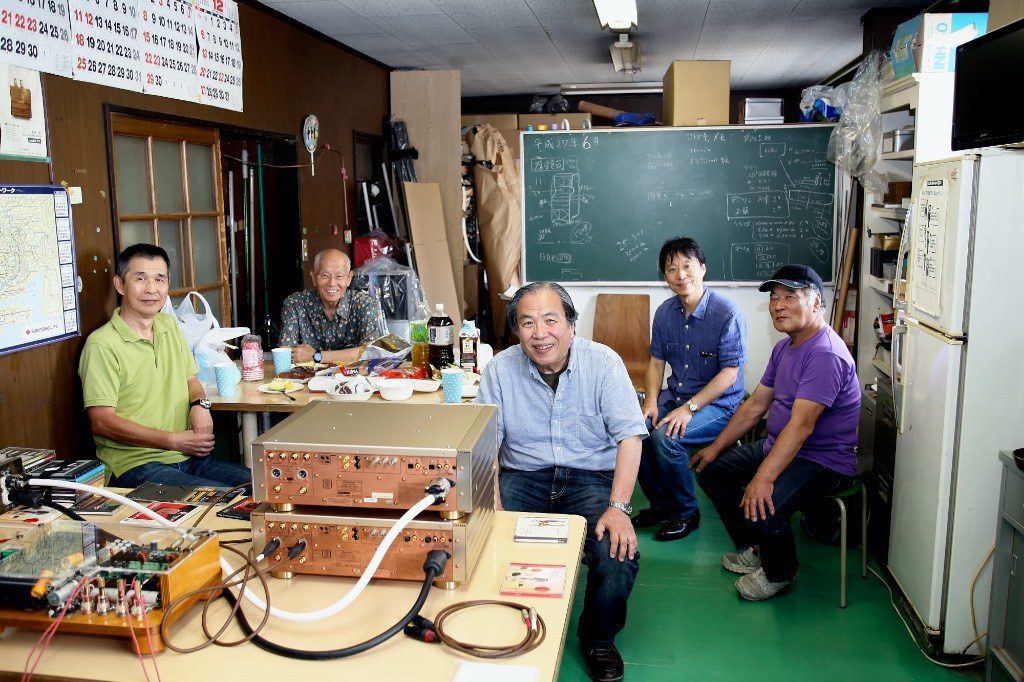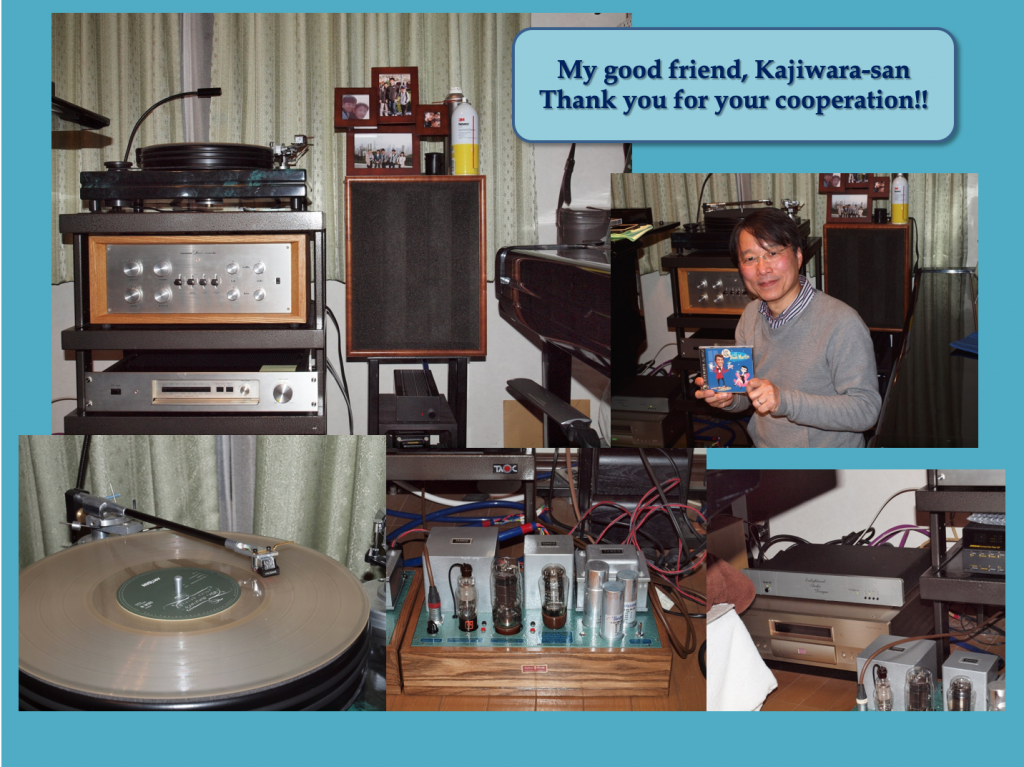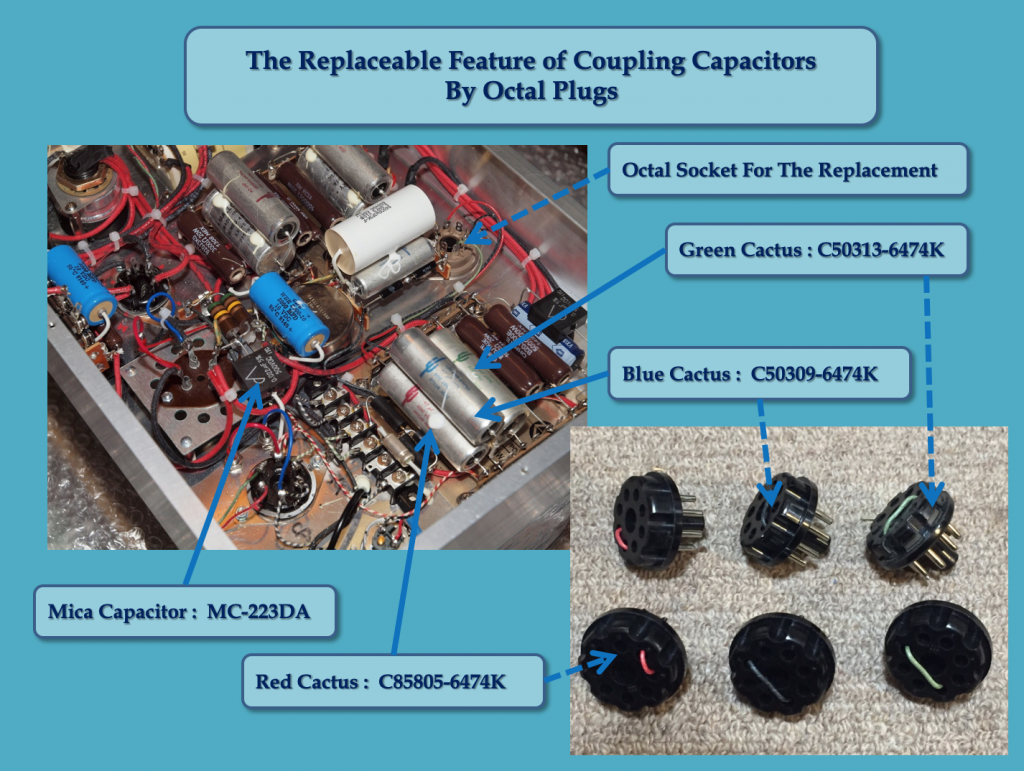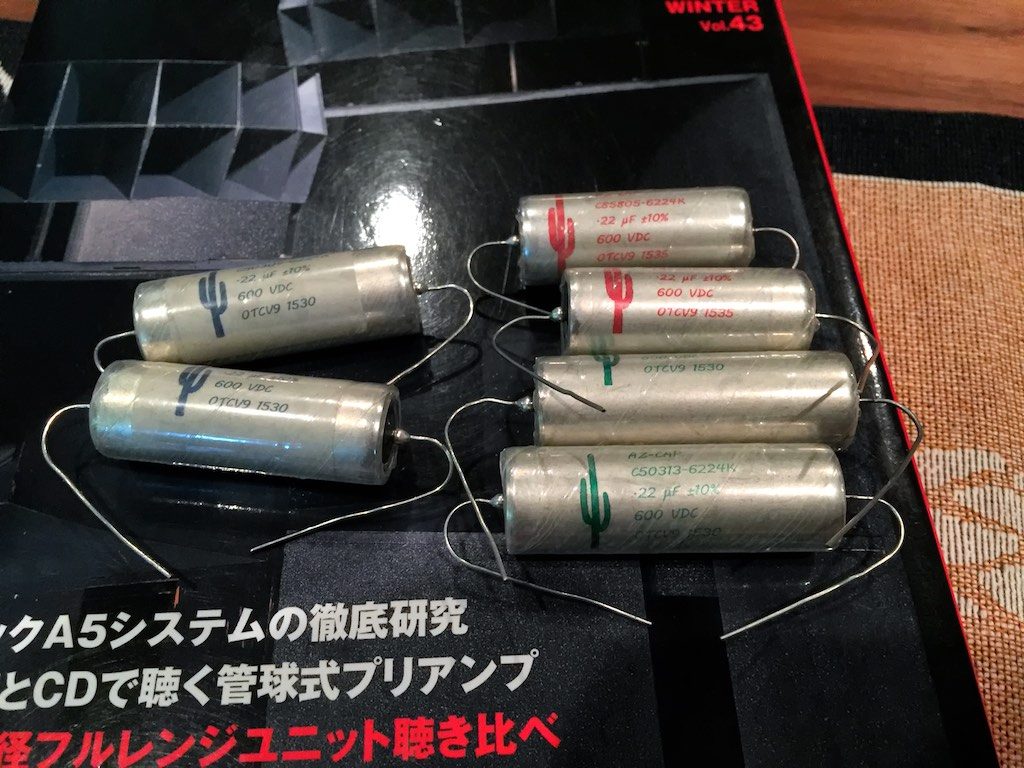It's always a pleasure to hear from Yazaki-san, and this article is the third in the series about Yazaki-san's audio adventures with the custom GEC PX25 monaural SET’s!

Yazaki-san (center) with friends in Tokyo.
You can read Part 1 HERE, and Part 2 HERE.
Enjoy!
¸¸.•*¨*•♫♪ ¸¸.•*¨*•♫♪ ¸¸.•*¨*•♫♪
Alan-san’s GEC PX25A (DA30) Monaural SET, Part 3: Dedicated to Alan-san and Harald-san
One Big Surprise for me
I experienced an epoch-making episode in my long “Audio Adventure” of more than 45 years.
I successfully completed another pair of SET's early last December - the same type as Alan-san’s PX25A (DA30) monaural SET's - for Harald-san, who lives in Switzerland.
Harald-san had collected old TANGO transformers, including valuable used FW-50-5S output transformers, and asked me if I would build up some SET's like Ookubo-san’s, about three years ago now.
Harald-san has waited patiently for the completion of this amplifier, and I was so happy to build it for him and get it completed. Before sending it to Harald-san, as a matter of course, I wanted to do some reliability and listening evaluations to make sure it met all my intentions.
I was really looking forward to experiencing the true potential of these monaural SET’s driving power. As I've always said before, high-efficiency speakers would be needed for taking full advantage of such a single-ended power amplifier, and so I suggested to Alan-san that he try the vintage Altec Corona loudspeakers.
Surely, this challenge would be fully successful according to Alan-san’s impressions in Part 2, but I never had as much time as I would have liked to listen to them, and never had the opportunity to try this combination of the WE-310A driving a PX25A (DA30) in monaural SET's on an under 90 dB low-efficiency speaker.

So I asked Kajiwara-san, my good friend, if we could install these SET's into his system to hear its sound on his beloved Linn Sara 9 loudspeakers, with a sensitivity of 88 dB/W/m. My good friend Kajiwara-san has an original Model 7, modified as I have written about here in my articles about my adventures with my own Model 7. Kajiwara-san also loves using a Shure V15 type 3 + VN35MR phonograph cartridge, just as I do.
It was really a big day, last December 8th, not only for me but also for my kindred spirits, Kajiwara-san and Nishikawa-san, when we experienced and shared the memorable sound of these PX25A (DA30) monaural SET's at Kajiwara-san’s home.
The music flowed out and filled everywhere in his music room shared with two acoustic pianos. It was not just sound, but rather the music itself, so rich and organic, and just as Alan-san has always described it, so emotionally satisfying.
Once we heard them, we were so moved at the way PX25A (DA30) monaural SET's reproduced the music, we couldn't put into words what we were hearing, and the only thing we could do was look at each other and marvel at what we were hearing.
The PX25A (DA30) monaural SET's were truly powerful, with a fount of information overflowing throughout the entire range of music, and also with the richest tone, composed of an infinite amount of clear musical colors.
Above all, we felt the sound and tone was so natural and organic, and furthermore, we fully enjoyed playing back music not only from LP's, but also with CD disks!
Anyways, these monaural PX25A (DA30) SET’s have a maximum power output that would be around 8 watts, so can you imagine our surprise at how easily they drove the 88 dB/W/m loudspeakers of Kajiwara-san’s. Of course, I would never have believed it before we experienced it that day at Kajiwara-san’s. It would have never occurred to my mind how well these mono SET's could drive modern low-sensitivity speakers.

What is True Power or Powerful Sound?
I thought long in my mind and heart about why and how these monaural PX25A (DA30) SET’s could feel so powerful, after hearing such memorable sound on Kajiwara-san’s 88 dB/W/m loudspeakers.
The answer to that question would be one of the keys to open the gate for “Real-Sound” for many more listeners, something I have long hoped to do.
Now, first of all, let’s go back to the physical principle. The speaker is the transducer, transforming electric energy to kinetic energy, and the speaker moves by the input current or energy from power amplifier, not its voltage.
In short, the power amplifier’s role is generating the electrical current for driving the speaker, and in the power amplifier the input signal or voltage is transformed to its current. Well, it’s only my hypothesis but I think that we might feel naturally the transitional speed or accelerated velocity of the power amplifiers' current.
Yes, I’d like to say that the maximum power experienced is surely related to the power amplifiers maximum current, but that is only a static measurement, and to realize the full dynamic behavior of the current as it flows from the power amplifier to the speaker, you have to listen to it for a true "measurement".
So the low measured value of its maximum power would not be proportional to our feelings about how powerful the monaural PX25A (DA30) SET’s sounded while we were listening on Kajiwara-san’s low-sensitivity loudspeakers.
So I began to wonder about what describes this powerful effect of the current speed.
I think there would be two main factors, the first being the quality of power supply, because the current flows from the power supply, and the second would be the transient response of transforming from signal voltage to the current in the final stage of power amplifier.
About the quality of the power supply, you could see my past articles, “My Adventure with My Old Marantz Model 7”, Part 2 and Part 3.
Capacitor for the Power Supply
When I build up the traditional power supplies for my tube amplifiers, and also for my Class-D amplifiers, I install a hermetically sealed oil-filled capacitor into the subsequent stage of the rectifier tube or diode, connected in parallel with the main electrolytic capacitor for rectification, and its addition provides a more responsive and organic sound.
As you might imagine, the addition of a 0.22~0.47 oil-filled capacitor in this position improves the sound dramatically, addressing the sonic weaknesses of the electrolytic style of capacitors, I suppose.
This improvement could be explained through the measured value of E.S.R. (Equivalent Series Resistance) for the higher frequency range, for example, at more than 10 kHz, for the oil-filled capacitor and the electrolytic capacitor. Actually, the E.S.R. value of an oil-filled capacitor in the higher range is much lower than with an electrolytic capacitor.
E.S.R. would be regarded as the inner electrical resistance of the capacitor, and so it could be expressed as the speed of the current coming from the capacitor, but we can’t explain the sound differences with only the value of E.S.R.
Generally, the latest metalized polypropylene capacitors (PP) are proud of their lower value of E.S.R. compared to hermetic seal oil-filled cap, but their sound and tone is far different when compared to the oil-filled capacitor.
When we connect capacitors in parallel with an electrolytic capacitor, I much prefer the sound of the oil-filled capacitor because of its organic tone, which is so sweet & beautiful to my hearing, and I suppose almost all of the readers of Jeff’s Place would like the tone of hermetic sealed oil-filled capacitor too.
I would like to express the reason why this is so in the article about the coupling capacitor a little later on.
Well, the way of installing an oil-filled capacitor for signal use on the way out of the diode or rectifier tube of your power amplifier could also be very effective for improving the tone and the sound, and so I strongly recommend this method to you.
Summing up, the way of improving the sound quality by modifying the power supply of Model 7 is also exactly true for a power amplifier.
Well, I have no other choice in this case but to say to the eager readers of Jeff’s Place, that when you see the power supply composed of only huge sized electrolytic capacitors for example in the brochure of the usual high powered semiconductor amplifier, it would not be false that you could imagine and think that the sound would be almost dull.
The E.S.R. characteristic of the high range on huge electrolytic capacitor is so poor because of the influence of their higher inductance value.
Yes, it is right that a low-impedance power supply's low-range could be stable and rich because of its lower E.S.R. value, but that low-impedance only exists in its low range.
If we longed for hearing the sound with much musicality, more lively and vivid, we should recognize the critical weakness of electrolytic capacitors in the high frequency and also try to compensate for it.
I’d like to share one more technique for improving the E.S.R. characteristic from the low-range to the mid-range by using multiple electrolytic capacitors connected in parallel, in next article, Part 4.
Of course, you could see my technique in Alan-san’s and Harald-san’s monaural SET's.
True Advantage of Triode Single-Ended Amplifier
Now, I’d like to talk about the transient response of transforming from signal voltage to the current in the final stage of power amplifier.
This theme converges with the advantages and disadvantages of each types of power amplifier, for example, such as a tube amplifier, or the usual semiconductor and Class D amplifiers, but that would overly complicate this discussion, so I will focus on the case of the triode single-ended power amplifier.
I think the power tube could be called some kind of transducer, from no little signal with bias voltage, applied on its grid to the current, overlapped with the signal, from plate to cathode, about 60 ~ 70 mA in the case of PX25A (DA30).
The current also flows in the primary winding of the output transformer, and so it could be said it is the load of the power tube. In this transformer, the electrical power, the current is literally transformed to ampere level current, and flows out from the secondary winding to the loudspeaker.
Thinking that way, its transient response or time, from the grid voltage to the final current to speaker, could be decided by only two parts, a power tube and an output transformer.
Also, we can’t find out substantial transient time of each component, I suppose. Well, I’d like to introduce you my good friend, Mr. Jun Honda, who is a genius engineer of latest Class D amplifier designing and works in Infineon Technologies. And his solutions, the reference design and the devices have been adopted in our Spec Corporations’s Class D amplifier.
Very recently, just a week ago, I shared our impressions of listening to the PX25A (DA30) monaural amplifiers at Kajiwara-san’s on his 88 dB/W/m loudspeakers, and he promptly replied back to me:
“I also think the triode single-ended amplifier is the best for music playback. Even today, there is nothing else like such a simple solution as the SET to amplify the signal, so I have been developing the circuit design of a Class D amplifier with the mindset of how to approach the performance of the triode SET."
"I just came back from CES this year, where we listened to the music from our latest cutting edge solution, which was only 200 mW, and this sound would evoke a new world of high-efficiency just like we feel from vintage high efficiency speakers, but also, when I experienced the sound, this Class-D solution could drive easily JBL double woofer system, 97 dB, and I felt that a new era of audio had just arrived."
"The resolution and power handling linearity of the sound was truly outstanding, and realizes the true organic warmth just like the triode SET amplifier has. Unfortunately, sound quality of these new parts has been loses something due to mass production efficiency. What is really amazing is the goodness of the vintage tubes and old Tango transformers, produced more than 40 years ago now, as you have just shared with me, Yazaki-san”.
In this mean time, as a conclusion for this chapter, I’d like to express again that the solution of triode single-ended amplifier would be the simplest one, and so it could bring out the remarkably high speed transient response with no loss, transforming from signal voltage to the final current to speaker.
In particular at this time, Harald-san’s SET's are composed of the PX25A (DA30), a truly valuable vintage direct-heated triode, and the very rare and high efficiency old TANGO FW-50-5S output transformers. and through them Kajiwara-san, Nishikawa-san, and I, felt the full nuance and organic warmth in vocals and other music playback.
The Replaceable Coupling Capacitors
About the coupling capacitor for these SET's, I decided to use Arizona Cap, 0.47 microfarad capacitors, and our mica 0.22 microfarad capacitors (MC-223DA), connected in parallel, because this combination could only offer the true potential of WE310A drive PX25A (DA30) monaural SET, I believe.
But, to tell the truth, it was a challenge for me, which coupling capacitor to use, Red, Blue or Green Cactus by Arizona Capacitors, Inc., for Alan-san’s and Harald-san’s amplifiers because each has different desirable characteristics.

It occurred to me that I could make a replaceable feature for the coupling capacitor, and found that it might be possible in the space available to install these sizable Red, Blue. and Green Cactus, 0.47 microfarad capacitors.
Fortunately enough, I was able to do this by using octal plugs so for this feature of being able to replace capacitors.
Before I express the impression the sound of each capacitor when used in Harald-san’s PX25A (DA30) monaural SET's, I’d like to repeat an excerpt from my past article about Arizona Cap's:

Arizona Capacitors Red, Blue, and Green Cactus capacitors.
Type C 85805, Red Cactus
At first we ordered a custom capacitor made of only Kraft paper and aluminum foil, that was our prototype of the Red Cactus. Yes, the Red Cactus is a genuine paper in oil (PIO) hermetic sealed capacitor. The tone might fit best for chamber music, especially for violin and female vocals, I believe. That's why I called it Red Cactus, as the attractive tone reminded me of a certain beautiful Hollywood movie star from the old days. Even now, we use this Red Cactus as the main capacitor in our top of the line amplifier, SPEC RSA-F33EX, and the Red Cactus is Banno-san’s personal choice for its pure tone.
Type C50309, Blue Cactus
The type C50309, which I called the Blue Cactus, was developed to compensate for some of the weakness in the low range of the Red Cactus. The dielectric materials of the Blue Cactus are made of a combination of Kraft paper and Mylar film. Accordingly the construction of the Blue Cactus was just the same as the vintage NOS West-Cap, which I had so loved. The greatest virtue of the Blue Cactus is its recreation of the rich and powerful sound of the vintage hermetic seal capacitors made in USA, and so the sound has a gorgeous and strong mid-low range. Of course, the sound of this Blue Cactus surpassed the vintage West-Cap with the amount of transmitted signal information, especially in the mid-high range. In other words, we could say that the dynamic S/N ratio, and frequency range, were much improved to our hearing.
Type C50313, Green Cactus
The type C50313, Green Cactus capacitor, was released in the summer of 2014, as our latest Arizona Capacitor in Japan. I wanted to achieve a brand-new sound for a hermetic seal capacitor, and Daryl-san’s (the former general manager of Arizona Capacitors, Inc.) idea was to increase the thickness ratio of Kraft paper to Mylar film.
Our goal was that the tonal character, from mid to high end, would be close to the sound of the Red Cactus capacitor, a genuine paper in oil (PIO) capacitor, but with the added benefit of a mid-low range that would be like the Blue Cactus capacitor.
It turned out the sound of the Green Cactus capacitor was nothing like a vintage capacitor’s sound, and the Green Cactus capacitor has clarity through its entire exceptionally wide range.
I feel somewhat like the Green Cactus capacitor has the sound of the best polypropylene film capacitors, but it is still very organic and natural sounding, which is something polypropylene film could never achieve at that level. And so I believe, this Green Cactus capacitor could easily fit in well for a high-resolution music source in the present day.
We have not yet brought out the latent potential of Green Cactus in our amplifier, but you could already hear and experience the sound of the Green Cactus capacitor with our Real-Sound Processor, RSP-901EX (and RSA-AZ9EX also).
When I named the Green Cactus, I was thinking of the majestic scenery of Yosemite National Park in California, filled with granite cliffs, waterfalls, clear streams, and its beautiful giant green sequoia groves.
For about one month, from 8th last December to the 5th of this January, Harald-san’s brand new monaural SET's had been undergoing long reliability and listening testing at Kajiwara-san’s home.
Of course, he had reported to me frequently about the sound of each capacitor, according to its burning-in time. Every time, he looked so excited, because he said that he had never experienced such a sound before. I could easily imagine that the burning in process for the SET's would be going well.
On the 5th of January, during Kajiwara-san’s new year’s vacation, I visited him again at his home, to pick up the monaural SET's, and for a listening session with Kajiwara-san.
Especially, I wanted to have time for hearing the comparison between the Red, Blue and Green Cactus capacitors, and also to experience how this new feature of allowing for replaceable capacitors would work. In terms of results, Kajiwara-san and I fully enjoyed hearing the difference in the sound of the Red, Blue, and Green Cactus Arizona Capacitors, which were so easy to replace with the addition of the octal plugs.
Pure Timbre of Red and Deep sound of Green Cactus
The most impressive things this time for us were the purely beautiful tone of Red Cactus and the outstandingly substantial sound of Green Cactus.
About Red Cactus, I was so surprised that when we heard the CD playback of a violin sonata by Akiko Suwanai, how the detail of the fine timbres weaving together was just the same as I heard from her performance at our city hall around one and a half years ago.
Well, the combination of Red Cactus and the mica capacitor (MC-223DA) surely brought out outstandingly pure and beautiful timbre, as I have longed for in the real playback of violin. This rare playback of the violin might also in part be owed to the sound quality of the soft dome tweeter of Linn Sara 9, I felt, and when we connected our RSP-AZ9EX to the speaker terminal of the SET, our surprise has reached to the climax.
The AZ9EX exactly compensated the low-range of the Red Cactus and offered us an almost perfect tone balance, and a more attractive sound, and yes, we recognized this would be the “Real-Sound”.
Next, we replaced the Red plug to the Green octal plug. We could easily distinguish the sound differences between the Red and the Green.
What a rich hall tone and perfectly overlapping harmonies the Green Cactus and the MC-223DA allowed us to hear. If you love classical music, especially its instrumental music, I strongly recommend you to try the Green Cactus.
You could understand well that the 0.47uF Green Cactus gives a deep expression of the music with very rich low range, which fit very well with the Linn, Sara 9, a small size speaker.
Please note that the burning in time for Green Cactus is rather longer than Red and Blue, Kajiwara-san and I have found.
For jazz music, the Blue Cactus would fit well. We felt featured vocal and instrumental performances to be very engaging.
Anyways, what a marvelous thing it is for Alan-san and Harald-san, true music lovers, to be able to fully enjoy all kinds of great music from around the world, with a simple and quick change of the Arizona Capacitors depending on the mood of the music.
I’d like to mention that there are never ideal capacitors in all ages and countries, and each capacitor has some kinds of sound character potential, but the remarkable advantage of the Arizona Cap’s is providing such good sound and tone with a feeling of “organic warmth”, so rare to find at present, and succeeded in showing these virtues of the American vintage capacitors.
Well, only the highest performing mica capacitor could come so close to the ideal characteristic as a signal capacitor, and we never felt any disadvantages for its sound character, but furthermore, we could see the transparently clear blue sky in the tone.
I simply hope that the eager readers of Jeff’s Place will try this combination in your amplifier modifications.
Well, Alan-san and Harald-san, thank you again for giving me the valuable chance to build up such a splendid PX25A (DA30) monaural SET and to deeply consider the work of power amplifier.
In the Part 4 of these articles, I want to continue our adventure and share with you the way of P-K feedback, from the plate of PX25A (DA30) to the cathode of WE310A, for improving the sound quality, and how to strengthen of its power supply, including direct-current lighting for PX25A, 4V / 2A.
¸¸.•*¨*•♫♪ ¸¸.•*¨*•♫♪ ¸¸.•*¨*•♫♪
Please allow me to share some thoughts from Alan-san about these amplifiers:
"I find that these Western Electric 310A/ PX25A SET amplifiers are wonderful musical instruments. For me, these SET amplifiers allow for an unparalleled continuity with the presentation of musical instruments in life, which has been an ongoing and engaging one-of-a-kind involvement with the music for me. There is a sense of palpable energy that brings forth strong feelings over a range of emotional responses, as I hear the "Real Sound" that is presented though these wonderful amplifiers."
"Yazaki-san was able to build up an amplifier that allows a change in flavor via the capability to “roll” capacitors, and what fun it is to hear these qualities from the Red, Green, and Blue Cactus Capacitors! Having these three choices available makes it possible to complement the musical textures that are waiting patiently to come to life."
"I find that the PX25a tube has a wider frequency range than the Western Electric 300B tube. The Px25A tube runs deeper into the foundational frequencies and extends further in the higher frequencies allowing for more tangible information and air in the presentation."
All I can say is "Wow, what a wonderful article by Yazaki-san!"
I find all the thoughts expressed in the design to be very intriguing and illuminating, and I love the idea of making the coupling capacitors as easy to change as a vacuum tube!
Please join me in thanking Yazaki-san for writing this fascinating article, and thanking Alan-san, Harald-san, and Kajiwara-san for making such an adventure possible!
You can find links to all Yazaki-san's audio adventures HERE in the Archives.
As always, thanks for stopping by, and may the tone be with you!



























